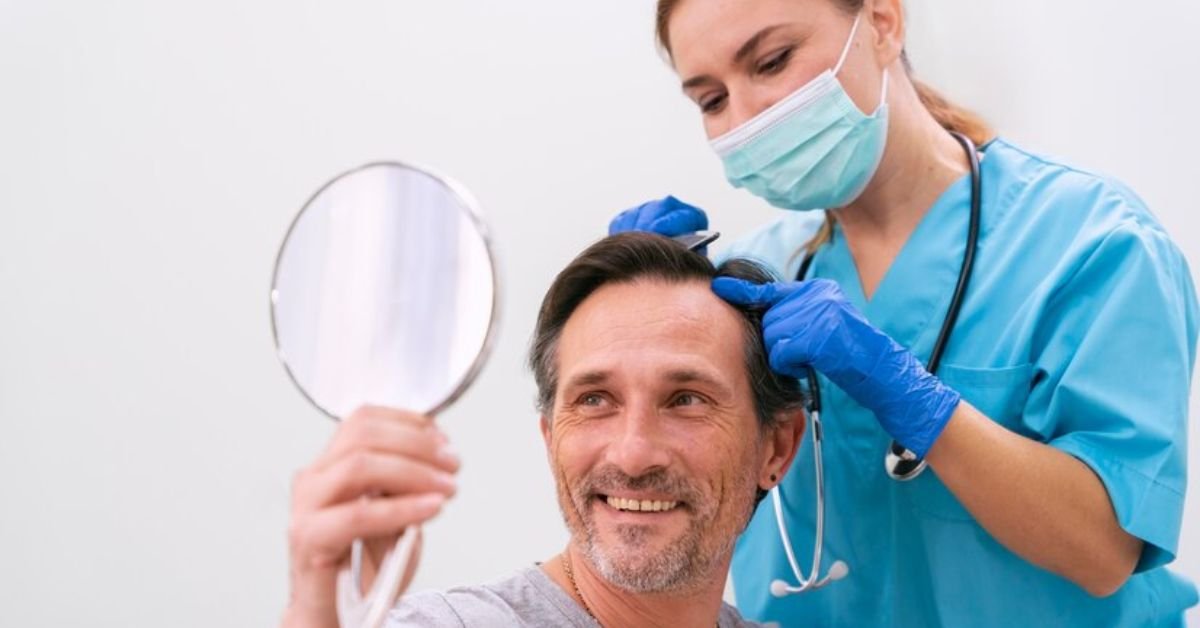Health
Recovery After Hair Transplant Surgery: What to Expect

When considering any medical procedure, it is crucial to understand what the healing and recovery process will entail. This is particularly true for a Longevita hair transplant or elsewhere, where the recovery period can be pivotal in achieving optimal results.
Immediate Post-Surgery Phase
Following the procedure, your surgeon will apply a dressing to the treated area, which should be kept intact for at least a day or two. Small crusts may form around each transplanted hair, but these should naturally fall off within a week or two. It’s normal to experience some discomfort, swelling or redness, which can usually be managed with prescribed painkillers and delicate washing with a special shampoo.
First Few Weeks of Recovery
During the initial weeks following your hair transplant procedure, you may experience what is referred to as ‘shock loss.’ This is a temporary shedding of transplanted and some surrounding hair caused by trauma to the scalp. While this might be disconcerting, do not panic – this is a common part of the healing process, and the hair will typically grow back.
Two to Four Months Post-Surgery
During this period, you might notice that your transplanted hairs begin to grow quite thin and sparse. This is yet another common occurrence and is a result of your scalp continuing to heal from the procedure. Given a little more time, these hairs will thicken and become denser. To support the healing process, some patients use red light therapy at home to promote hair growth and improve scalp health.
Six Months Post-Surgery
By around six months, the results of your hair transplant should start to become apparent. Hairs in the treated areas should be significantly denser and thicker than before, and you will likely start noticing an improvement in the overall appearance of your hair.
One Year After Surgery and Beyond
A year after the surgery, you should be able to see the final results of the procedure. The transplanted hairs will have fully matured, grown longer, and thickened, giving you a fuller, healthier-looking head of hair.
Things to Remember
It’s important to remember that while hair transplant surgery can drastically improve the appearance of thinning or balding hair, it is not a magic fix. Maintaining your newly transplanted hair will require continuous care and perhaps even additional treatments in the future. Lastly, be patient- good things take time! Hair transplant recovery is a gradual process, and the full results may not be visible until a year after the procedure.
Conclusion
Undergoing a hair transplant can be a significant decision, but by understanding what to expect during the recovery process, you can make an informed choice and better manage your expectations. Remember, while the process may be slow, the results can be life-changing.
Health
Understanding the Eligibility Requirements for Medicare and Respite Care

Medicare and respite care are important for many families. These services help provide support and relief for caregivers. Understanding them can make a big difference in managing care for loved ones.
Many people don’t know how Medicare can help with respite care. Learning about these services can ease stress and improve care. This blog aims to understand the eligibility requirements for Medicare and respite care.
Age and Disability Considerations for Medicare
Age plays a major role in Medicare eligibility. Most people qualify when they turn 65. This age mark is key to accessing vital health services.
However, age is not the only factor. Many young adults with disabilities also qualify. These individuals can benefit from respite care services through Medicare.
Both age and disability influence care options. This connection is important to understand. By learning about these factors, families can take advantage of respite care options.
Income and Resource Limits for Medicare Eligibility
Income limits affect Medicare eligibility. People must meet specific financial requirements. Understanding these limits is crucial for accessing aid.
Resource limits also play a part. Individuals can only have a certain amount of assets. This can impact their eligibility for Medicare financial aid and care programs.
Awareness of these limits helps families. It allows families to explore all possible aid options. This exploration can lead them to the best support programs available.
The Role of Healthcare Providers in Medicare Eligibility
Healthcare providers can help families understand eligibility. They provide guidance through the medicare process. This support can simplify access to needed services.
Doctors and specialists play a part in care. They can recommend necessary services and tests. Their insights help families navigate Medicare and respite care in a more informed manner.
Clear communication with providers is essential. It ensures families make empowered choices. In the end, this leads to better care outcomes for everyone.
Understanding the Different Parts of Medicare
Medicare has four main parts that help cover different health needs. Part A covers hospital stays, and Part B covers doctor visits. These are the most common parts people use.
Part C, also called medicare advantage, offers more options like vision or dental. Part D helps pay for prescription drugs. Knowing these parts helps you choose the right care.
Each part has its own benefits. Understanding them can help with better planning. This ensures the best health support.
Eligibility Criteria for Medicare Coverage
Medicare eligibility depends on a few key factors. Most people qualify at age 65, but some with disabilities can apply earlier. U.S. citizenship or legal residency is also required.
Understanding these guidelines helps you access necessary care. This is important for maximizing respite room benefits, which provide relief for caregivers. Knowing your options is crucial.
Medicare also supports optimal healing. Having the right coverage ensures better recovery and well-being. This leads to improved health outcomes for everyone involved.
Closing Thoughts on Medicare and Respite Care
Understanding Medicare and respite care is essential for families seeking support. Knowing the eligibility criteria helps ensure you receive the right services. This knowledge empowers caregivers to make informed choices for their loved ones.
Families can benefit from this understanding as they navigate their care options. By being aware of what Medicare offers, caregivers can access valuable resources. In turn, this leads to better care and support for everyone involved.
Did this article help you? If so, take a look at some of our other blog posts for more informative reads.
Health
A Guide to Choosing the Right General Dentist for Your Family

Choosing the right general dentist for your family is crucial. You want someone who keeps your smiles healthy and bright. How do you find this perfect match for your family?
General dentists handle routine check-ups and offer cosmetic dentistry. These services include teeth whitening and veneers, catering to your family’s diverse needs.
It’s essential to know your priorities for dental health. Are you aware of your dental care requirements?
With the right dentist, your family enjoys peace of mind and excellent oral health. Let’s explore.
Knowing Your Dental Needs
Understanding your family’s unique dental needs is the first step in choosing the right general dentist. Some important factors to consider include:
Age
Children have different dental needs than adults. It’s essential to choose a dentist who specializes in pediatric dentistry.
Previous Dental History
If you or any of your family members have had past dental issues, it’s crucial to find a dentist. They should be able to address those specific concerns.
Insurance Coverage
It’s always wise to check if the dentist you’re considering accepts your insurance plan. Additionally, inquire about any affordable payment options they may offer.
Researching Potential Dentists
Research potential dentists in your area. Some helpful ways to do this include:
Asking for Referrals
Start by asking friends, family, and coworkers for recommendations. They can provide first-hand experiences and insights into the quality of care.
Reading Online Reviews
Check out websites like Google or Yelp to read reviews from previous patients. This gives you a better idea of the dentist’s reputation.
Checking Credentials
Look for general dentists who are board-certified. Ensure they have the proper licensing and credentials.
It’s also essential to consider the location and office hours of the dentist you’re interested in. You want someone convenient and accessible for your family’s busy schedule. If you want to go to a great dentist in Ottowa, check their availability and proximity to your home or work to ensure regular visits are manageable. Finding the right dental care can make a significant difference in your family’s oral health routine!
Meeting the Dentist and Staff
Once you have a list of potential dentists, it’s time to meet them in person. This is an opportunity to get a feel for the office and staff, as well as ask any questions you may have. Some things to consider during this meeting include:
- cleanliness and atmosphere
- communication style
- services offered
- emergency care
Making Your Decision
After meeting with potential dentists and considering all your family’s needs, it’s time to make a decision. Don’t be afraid to take your time and choose the dentist that feels like the best fit for your family. Some final things to keep in mind include:
- cost
- trust and comfort
- continued evaluation
Consider This Guide When Choosing a General Dentist
A general dentist plays a key role in family health. They offer essential dental services for all your family members. Finding the right dentist ensures bright smiles and happiness.
Always prioritize comfort, trust, and good communication with your dentist. Regular dental care keeps oral health in top condition. Evaluate your aesthetic dentists regularly for continued satisfaction.
Choosing wisely impacts long-term family dental wellness. Prioritize a dentist who understands your unique family needs.
Did you find this article helpful? If so, check out the rest of our site for more informative content.
Health
The Comprehensive Guide to Elder Care Solutions: Options for Every Family

Finding the right support for aging loved ones can feel like a big task for families. As people live longer and have different needs, the need for good elder care solutions has grown. Families want options that ensure their loved ones are safe. It also helps them stay happy and independent.
This guide will look at different choices available, like in-home care, assisted living, and senior living communities. By understanding these options, families can make informed decisions that best suit their loved one’s needs and ensure they receive the care and support they deserve.
Understanding Elder Care Solutions
Elder care solutions include many services made to help older adults. These solutions can be customized based on how much care is needed, personal choices, and budget limits. Seniors will need some kind of long-term care, highlighting the importance for families to know their options.
In-Home Care Services
In-home care services are great for people who want to stay independent while getting help tailored to their needs. This kind of care usually includes assistance with daily tasks like:
- bathing
- dressing
- cooking
- helping seniors live comfortably at home
Home care can be provided by professional caregivers or trained family members and can be adjusted as needs change.
Assisted Living Solutions
Assisted living offers a mix of independence and support. These places usually have private rooms and shared dining, fun activities, and staff available 24/7 to help. Many seniors feel happier in assisted living than living alone because of the various activities and amenities.
If you’re thinking about this option, check out Napa’s best assisted living community to find the right place for you.
Geriatric Care Options
Geriatric care includes different services designed for the special needs of older adults, often using a team approach. This can mean in-home care, assisted living, and special programs for chronic illnesses, memory loss, and comfort care.
Having professionals who know about geriatric medicine can help improve the well-being of elderly loved ones.
Choosing the Right Support System
When choosing elder care solutions, families should think about how much care is needed, the costs involved, and what the senior prefers. Talking openly about these things can help reduce some of the stress that comes with making decisions.
Also, learning about local resources and senior care tips can help families make better choices. To start, research the different options available. Compare them based on services offered costs, and reputation.
Tailoring Elder Support Systems to Individual Needs
Finding the right elder care solutions is essential for helping seniors live healthier and happier lives. Families should explore options like in-home care, assisted living, or specialized geriatric care. This is to discover what works best for their loved ones.
It’s important to communicate openly with seniors about their needs and preferences. By working together, families can create a supportive environment that prioritizes the well-being of older adults.
With this, families can ensure that their elderly relatives receive the care and support they deserve, leading to a better quality of life for everyone involved.
Did you find this article helpful? Check out the rest of our blogs!

 Entertainment5 months ago
Entertainment5 months agoSandra Orlow: Exploring the Life and Legacy of a Cultural Icon

 Business6 months ago
Business6 months agoTex9.Net Crypto: Fast, Secure International Money Transfers with Competitive Rates

 General2 months ago
General2 months agoDiana Nyad & Bart Springtime: A Swim to Success

 General2 months ago
General2 months agoBaby Alien Fan Bus: Watch Parts 2 & 3 on Twitter, Reddit!

 Business6 months ago
Business6 months agoSnapchat Planets: Exploring Your Streak Universe

 General4 months ago
General4 months agoDeeper Dive into myfavouriteplaces. org:// blog

 Business6 months ago
Business6 months agoFintechZoom Apple Stock: Real-Time Insights and Expert Analysis

 Business6 months ago
Business6 months agoWhat is O Farming: How to Make Money Online and Its Start-Up Benefits
















